Soil provides a structure for a plant to anchor its roots and is a source of nutrition and water necessary for plant growth. Soil-inhabiting insects also utilize this substrate for part of or for their entire life. Although many insects are dependent on soil for food and shelter, only a few soil-borne insects such as weevils, ants, and termites are detrimental to the citrus tree.
Citrus Root Weevils
Citrus root weevils represent a complex of species that infest citrus trees and alternate host plants in Florida. The most common weevil species infesting citrus (Figure 1), in order of greatest geographical distribution, are the blue-green citrus root weevils, Diaprepes root weevil, little leaf notcher and Fuller rose beetle with Diaprepes being the most injurious.
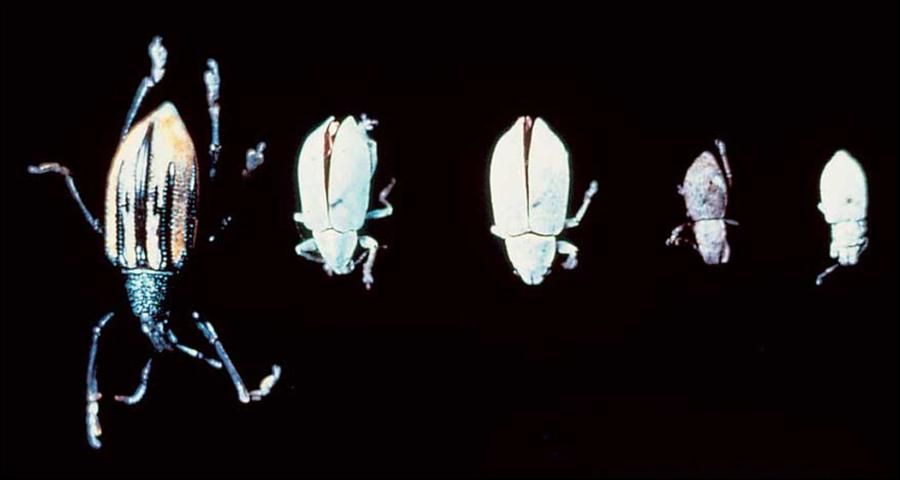
All citrus root weevils have a similar life cycle. The immature stages are: egg, larva, and pupa. The adult weevils emerge from the soil, feed on foliage, and lay eggs on host plants. After hatching, the larvae (Figure 2) enter the soil to feed on roots.
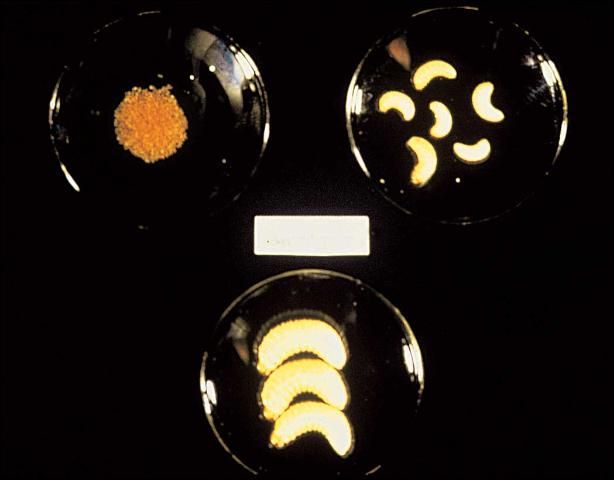
Adult citrus root weevils vary widely in size and color among species and sometimes within species. Most species can fly short distances which aids dispersal over a limited geographical area. The little leaf notcher and Fuller rose beetle are flightless.
All female weevils, except Fuller rose beetle, lay eggs between leaf surfaces in masses that contain a gelatinous substance which protects the eggs and holds the leaves together. Once the eggs hatch after about 7-10 days, the larvae fall to the soil surface. Invasive neonates feed on smaller roots but move to larger roots as they increase in size.
Larvae are white, grub-like insects, ranging in size from 0.125 to 0.75 inch in length. Large larvae cause damage by channeling the outer root bark tissue including the cambium layer or by girdling a root thereby causing root death.
Feeding damage by older larvae may be seen on major lateral roots (Figure 3) and in the crown region when a tree is removed from the soil.
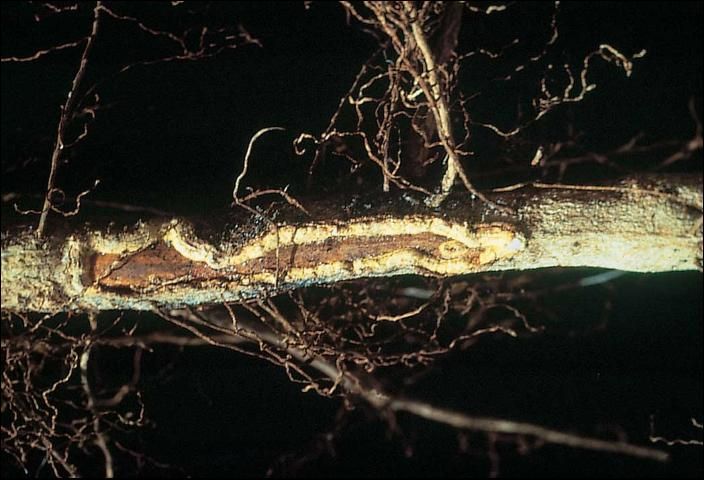
Credit: Photo courtesy of Sam Simpson.
Adults are semi-nocturnal; they can be found in the early morning or late afternoon on the outer foliage, but move deeper into the canopy during the day. When disturbed, they fall from the branch to the ground and can fake death.
Adults feed on the margins of newly emerged leaves producing a notched margin to the leaf. Notching patterns differ slightly among species and can be confused with grasshopper injury (Figure 4).
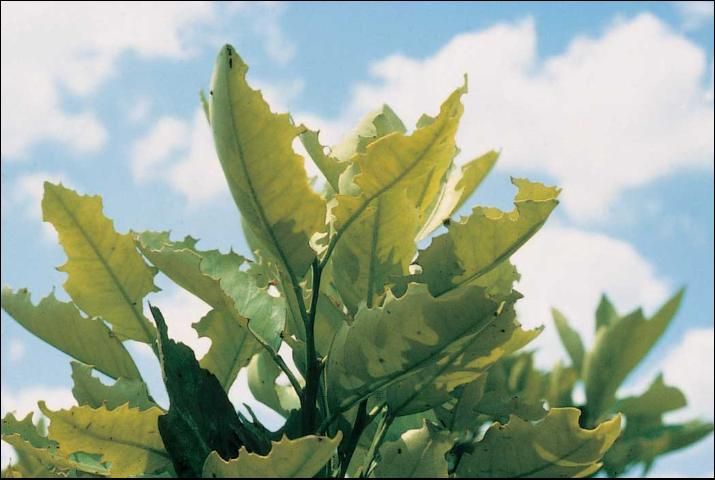
Credit: Photo courtesy of Sam Simpson.
Diaprepes Root Weevil - Diaprepes abbreviatus (L.)
The Diaprepes root weevil, also referred to as the sugarcane rootstalk borer weevil, was first reported in Florida in 1964 near Apopka. It is a major pest of citrus as well as many other plants (crops and ornamentals) grown in Florida and the Caribbean area.
This is the largest and most devastating weevil found in Florida citrus. The adult weevil is 0.37 to 0.75 inch in length. The adult wing covers have a black background with orange, gray or white bands (Figure 5).
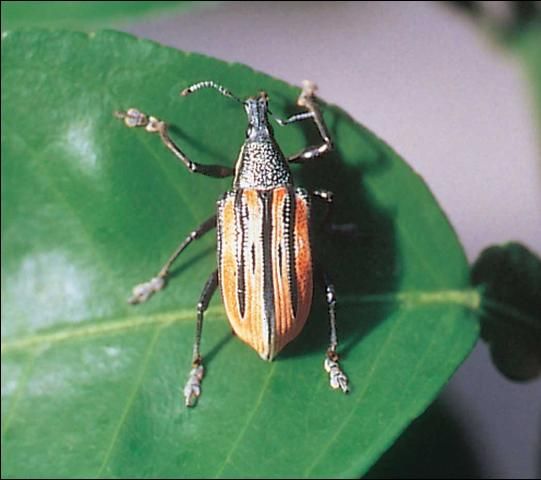
The females can lay up to 7,000 eggs during her lifetime. Eggs hatch in approximately seven days at 78oF. Adult males are active in the tree for 2-3 months while adult females are active for 4 months to one year.
The larva can have as many as 11 instars. The life cycle from egg to adult can take as few as 55 days or as long as one year. Adults can be found throughout the year. Peak emergence from the soil occurs in May-June but a second peak may occur in September.
Diaprepes have been found on many types of plants which support one or more stages of its life cycle in Florida.
Blue Green Citrus Root Weevils - Pachnaeus litus (Germar) & Pachnaeus opalus (Olivier)
Pachnaeus opalus is found in the northern areas of Florida and Pachnaeus litus is found in southern Florida (Figures 6 and 7).
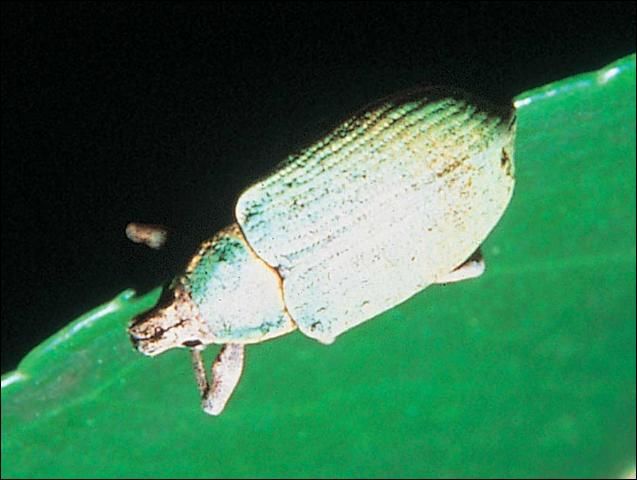
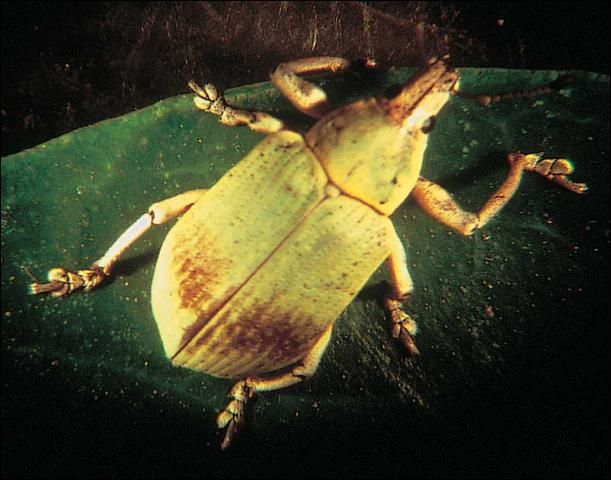
The species are closely related and overlap in central Florida and are very similar in appearance and behavior. They are bright blue-green to aqua in color.
The adults are 0.33 to 0.55 inch in length and can be found throughout the year. The average adult life span is 100 to 120 days.
The egg masses consist of 25 to 50 cream-colored cylindrical eggs. The female lays approximately 4,000 eggs over her lifetime. Eggs hatch in about 7 days.
Larvae fall to the soil surface, enter the soil, and feed on the fibrous root system.
Fuller Rose Beetle - Asynonychus godmani (Crotch)
The Fuller rose beetle was first reported in Florida in 1916 and can be found on a wide range of temperate to tropical host plants.
Adults are brownish to grey in color, about 0.33 inch long and can be found throughout the year (Figure 8).
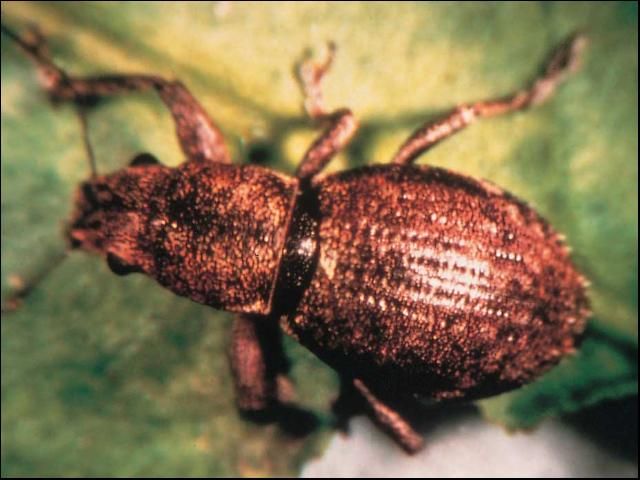
This species is flightless and only female. Adults lay 70 to 100 egg masses over 4 months. Eggs are somewhat flattened and deep yellow. They are found under the calyx of the fruit and on occasion in cracks and crevices in the tree. Eggs hatch in about 17 days.
Larvae fall to the soil surface and feed on the roots.
Little Leaf Notcher - Artipus floridanus (Horn)
Little leaf notcher was first reported in Florida in 1876 and is found mainly along Floridas east coast from Volusia County to the Keys. This species is the smallest of the weevils, measuring about 0.2 to 0.25 inch in length.
They are grayish-white in color, flightless, and all female (Figure 9).

The life cycle is 60 to 120 days with 3 to 4 overlapping generations per year. The female lays an average of 1,220 eggs during her life span.
This species has a wide host range of approximately 150 plant species. These weevils disperse by crawling or by passive movement on plants or equipment.
Subterranean termite - Reticulitermes flavipes (Kollar)
Subterranean termites generally do not feed on living plants and can be found on dead and decaying woody plant material. Subterranean termites are 0.20 inch in length and white to yellow in color. They are similar in appearance to ants (Figure 10).
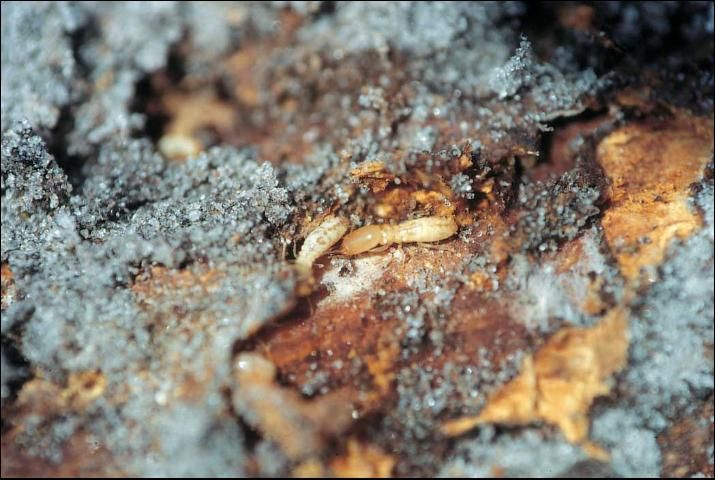
Credit: Photo courtesy of R. Rouse.
All subterranean termites must maintain contact with moist soil to survive.
When groves have been developed from pine and palmetto woodlands harboring a natural termite infestation, problems have developed when land clearing operations have left wood in the soil which provided a food source for termites. When the food supply becomes limited, termites may feed on the bark of the live tree trunk in a ring between the soil line and crown roots causing girdling and possible tree death. Feeding may advance above the soil line (Figure 11).

Credit: Photo courtesy of R. Rouse.
Girdling live wood has been a noted problem when trees were banked with soil for cold protection. Any wraps applied to the tree trunk for cold protection or sprout control should be carefully monitored for termites. Once termites are found, control measures should be instituted to reduce populations.
Red imported fire ant - Solenopsis invicta (Fabricus)
Many different species of ants are found in citrus groves. Some ants are beneficial, feeding on other pests of citrus, whereas others may be quite disruptive of biological control agents that attack citrus pests. Ants range in size from as small as 0.13 to 0.5 inch (Figure 12).
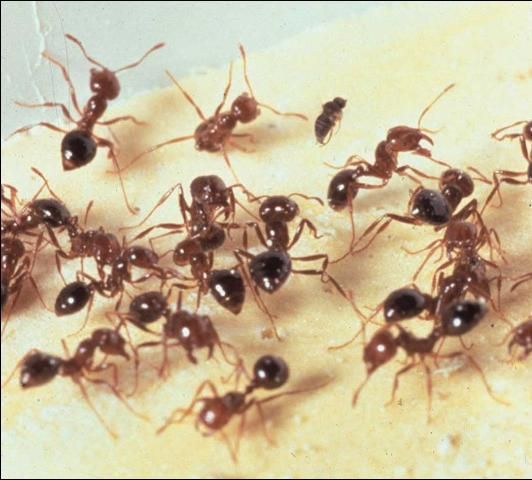
Credit: Photo courtesy of USDA-ARS.
The ant species that poses the greatest problem in Florida citrus is the red imported fire ant. It is reddish-brown to black in color and 0.13 to 0.25 inch long. Red imported fire ant is a social insect and capable of making colonies containing 250,000 individuals in mounds measuring 3 to 12 inches high and up to 3 feet in diameter. Fire ant colonies contain one or more queens, winged males and females, workers, and brood. Winged ants leave the colony on mating flights to establish new colonies. Colonies of ants may be built in areas near irrigation lines, beneath protective wraps on young trees or anywhere in the grove. When colonies are established near or under protective wraps, the ants will feed on the bark and tender new flush.
Once feeding occurs on the bark, the tree trunk can be girdled or wounds opened which allow pathogens to enter the tree. This damage can cause tree death. Ants within the grove can create problems for harvesters and production workers (Figure 13).
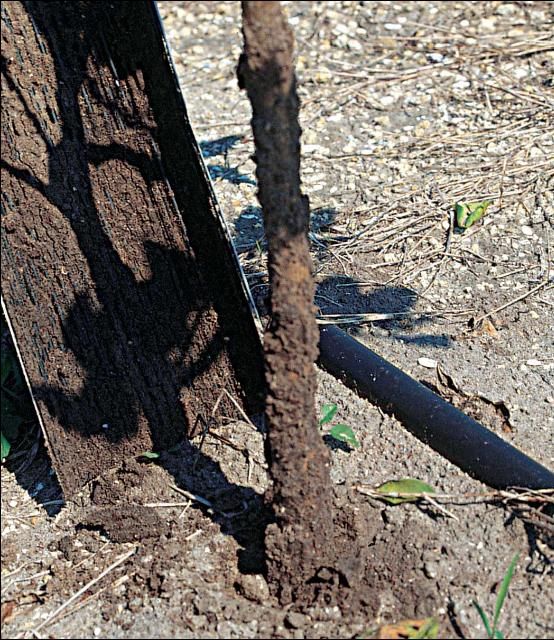
For more information on soil insect pests, you may wish to consult the annual Florida Citrus Production Guide published by the University of Florida Institute of Food and Agricultural Sciences, Gainesville, Florida.